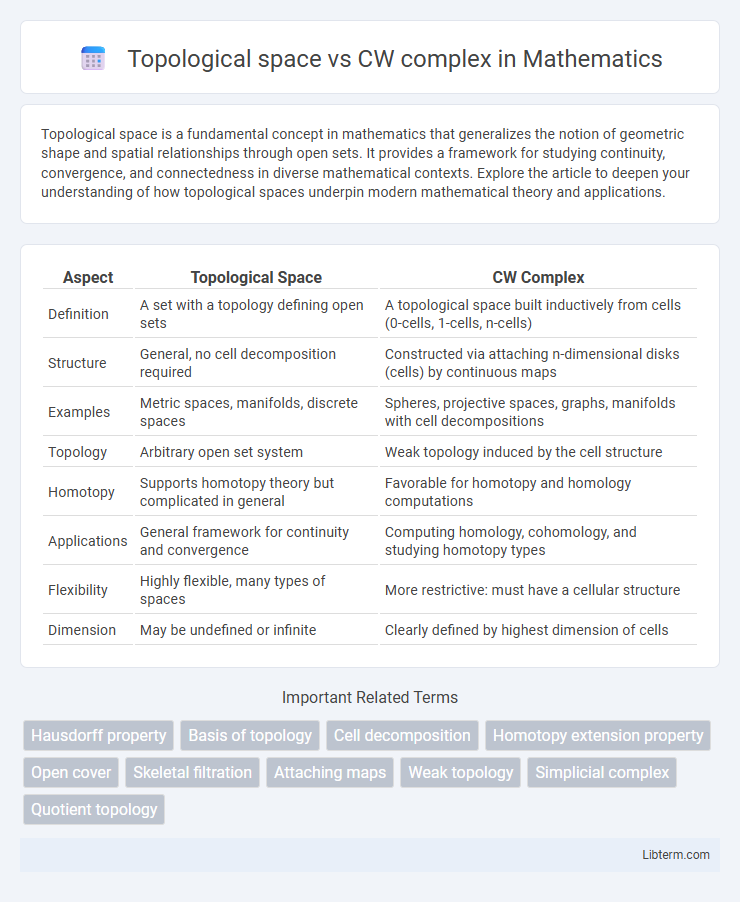Topological space is a fundamental concept in mathematics that generalizes the notion of geometric shape and spatial relationships through open sets. It provides a framework for studying continuity, convergence, and connectedness in diverse mathematical contexts. Explore the article to deepen your understanding of how topological spaces underpin modern mathematical theory and applications.
Table of Comparison
| Aspect | Topological Space | CW Complex |
|---|---|---|
| Definition | A set with a topology defining open sets | A topological space built inductively from cells (0-cells, 1-cells, n-cells) |
| Structure | General, no cell decomposition required | Constructed via attaching n-dimensional disks (cells) by continuous maps |
| Examples | Metric spaces, manifolds, discrete spaces | Spheres, projective spaces, graphs, manifolds with cell decompositions |
| Topology | Arbitrary open set system | Weak topology induced by the cell structure |
| Homotopy | Supports homotopy theory but complicated in general | Favorable for homotopy and homology computations |
| Applications | General framework for continuity and convergence | Computing homology, cohomology, and studying homotopy types |
| Flexibility | Highly flexible, many types of spaces | More restrictive: must have a cellular structure |
| Dimension | May be undefined or infinite | Clearly defined by highest dimension of cells |
Introduction to Topological Spaces and CW Complexes
Topological spaces provide a foundational framework in mathematics characterized by open sets that define continuity, convergence, and boundary concepts without requiring a notion of distance. CW complexes offer a structured way to build topological spaces using cells (disks of varying dimensions) attached inductively, enabling efficient computation of homotopy and homology groups. Unlike general topological spaces, CW complexes are constructed with a cellular decomposition, which facilitates both algebraic topology analysis and geometric intuition.
Historical Background and Development
The concept of a topological space originated in the early 20th century as mathematicians sought to generalize the notion of geometric continuity and convergence, with foundational work by Hausdorff and Kuratowski. CW complexes were introduced by J.H.C. Whitehead in the 1940s to provide a flexible and combinatorial framework for studying homotopy theory and algebraic topology. This development allowed for a more tractable approach to decomposing spaces into cells, bridging abstract topological spaces with algebraic methods and simplifying complex topological analyses.
Fundamental Definitions
A topological space is a set equipped with a topology, defined as a collection of open sets satisfying union, intersection, and inclusion of the empty set and the entire set, providing a framework for continuity and convergence. A CW complex is a specific type of topological space constructed inductively by gluing cells of increasing dimension via attaching maps, forming a hierarchy of skeletons that facilitate algebraic topology computations. The fundamental difference lies in the CW complex's combinatorial structure enabling cell-by-cell analysis, whereas a general topological space lacks this inductive cellular decomposition.
Core Properties of Topological Spaces
Topological spaces are defined by open sets satisfying union and finite intersection properties, providing a flexible framework for continuity and convergence. Their core properties include separation axioms (T0, T1, T2), compactness, connectedness, and Hausdorff conditions that govern the behavior of points and neighborhoods. CW complexes, built from cells of varying dimensions attached via continuous maps, impose combinatorial structure on topological spaces to facilitate homotopy and homology analysis.
Construction and Structure of CW Complexes
CW complexes are constructed by inductively attaching cells of increasing dimension via continuous maps from their boundary spheres to the existing complex, starting from a discrete set of points called 0-cells. This cellular structure provides a combinatorial framework that allows for easier computation of homotopy and homology groups compared to general topological spaces, which may lack such a skeletal decomposition. The closure-finite and weak topology conditions defining CW complexes ensure well-behaved topological properties that facilitate inductive arguments and algebraic topology techniques unavailable in arbitrary topological spaces.
Key Differences Between Topological Spaces and CW Complexes
Topological spaces are general mathematical objects defined by open sets, allowing for a wide variety of structures without restriction on construction, while CW complexes are specific topological spaces built inductively by attaching cells of increasing dimension. CW complexes possess a cellular decomposition facilitating homotopy and homology calculations through their cell structure, whereas arbitrary topological spaces may lack such combinatorial simplicity. The key difference lies in the constructive nature of CW complexes, enabling powerful algebraic topology techniques not generally applicable to all topological spaces.
Advantages of Using CW Complexes
CW complexes provide a structured approach to building topological spaces using cells of varying dimensions, enabling easier computation of homology and homotopy groups compared to arbitrary topological spaces. Their cellular decomposition offers a combinatorial framework that simplifies the analysis of continuous maps and homotopy equivalences. This cell-based construction enhances both theoretical insights and practical computations in algebraic topology.
Applications in Algebraic Topology
Topological spaces provide the foundational setting for studying continuous deformations, while CW complexes offer a combinatorial structure that simplifies homotopy and homology calculations. CW complexes facilitate the computation of algebraic invariants such as homotopy groups, cohomology rings, and spectral sequences, making them essential tools in algebraic topology. Their cell-by-cell construction enables explicit control over attaching maps, which is crucial for applications in areas like fiber bundle theory and obstruction theory.
Limitations and Challenges
Topological spaces often lack a combinatorial structure, making computations of homotopy and homology groups complex and less tractable. CW complexes provide a cellular decomposition that simplifies these calculations but struggle with non-manifold points and may not capture certain pathological topologies. Both frameworks face challenges in handling infinite-dimensional or highly singular spaces, limiting their applicability in certain advanced areas of algebraic topology.
Conclusion and Future Directions
Topological spaces provide a broad framework for studying continuity and convergence, while CW complexes offer a combinatorial structure that simplifies homotopy and homology computations. CW complexes enable efficient cell-by-cell analysis, making them indispensable in algebraic topology and geometric modeling. Future research may explore enhanced computational methods for CW complex decomposition and their applications in higher-dimensional topology and data analysis.
Topological space Infographic

 libterm.com
libterm.com